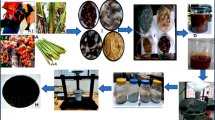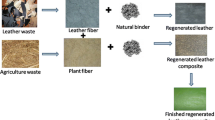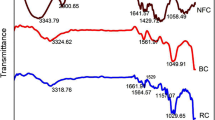Abstract
Releasing of large volumes of leather scraps wastes from different leather, footwear, and leather goods industries has become a major environmental pollution concern now a days in developing countries. Natural nanofibers are widely used as prospective reinforcement materials in formulation of different biocomposites materials. Herein, a new nanocomposite material has been synthesized and characterized using leather scraps wastes and Slender amaranth based nano-cellulose with latex in a clean environment perspective. Nano-cellulose was extracted from Slender amaranth vegetable wastes as natural fiber for green composites preparation. The extracted nanofibers, leather waste composite, and the resulting nanocomposite material have been characterized using X-ray diffraction (XRD), Fourier transform infrared spectroscopy (FT-IR), and Field emission scanning electron microscopy (FESEM). Different physio-mechanical characteristics of nanocomposite were evaluated which showed its potential applications as shoe upper components. The results revealed that addition of nano-cellulose significantly improved the physical properties of new composite sheet. SEM images revealed the surface morphology of nanocomposite which was observed to be predominantly homogenous with uniform distribution of particles. This novel nanocomposite exhibits different potential properties and TGA data showed higher thermal stability of this material in comparison to those obtained with control method. It can find application as a green reinforcement material in the preparation of different leather goods with improved mechanical properties and thermal stability. These significant findings highlight the preparation of a valuable biocomposite material from leather solid wastes which is cost effective and sustainable for leather industries as well as it emphasizes an effective approach to reduce environmental pollution.
Graphical abstract












Similar content being viewed by others
Data availability
This article contains all of the data created or examined during this investigation.
References
Fela K, Wieczorek-Ciurowa K, Konopka M, Woźny Z (2011) Present and prospective leather industry waste disposal. Pol J Chem Technol 13(3):53–55. https://doi.org/10.2478/v10026-011-0037-2
Tatàno F, Acerbi N, Monterubbiano C, Pretelli S, Tombari L, Mangani F (2012) Shoe manufacturing wastes: characterisation of properties and recovery options. Resour Conserv Recycl 66:66–75. https://doi.org/10.1016/j.resconrec.2012.06.007
Jones M, Gandia A, John S, Bismarck A (2021) Leather-like material biofabrication using fungi. Nat Sustain 4(1):9–16. https://doi.org/10.1038/s41893-020-00606-1
Karthik T, Gopalakrishnan D (2014) Environmental analysis of textile value chain: an overview. In: Muthu SS (ed) Roadmap to sustainable textiles and clothing: environmental and social aspects of textiles and clothing supply chain. Springer, Singapore, pp 153–188
Nigam H, Das M, Chauhan S, Pandey P, Swati P, Yadav M, Tiwari A (2015) Effect of chromium generated by solid waste of tannery and microbial degradation of chromium to reduce its toxicity: a review. Adv Appl Sci Res 6(3):129–136
Stahel WR (2016) The circular economy. Nature 531:7595. https://doi.org/10.1038/531435a
Thakur VK, Singha AS, Mehta IK (2010) Renewable resource-based green polymer composites: analysis and characterization. Int J Polym Anal Charact 15(3):137–146. https://doi.org/10.1080/10236660903582233
Thyavihalli Girijappa YG, Mavinkere Rangappa S, Parameswaranpillai J, Siengchin S (2019) Natural fibers as sustainable and renewable resource for development of eco-friendly composites: a comprehensive review. Front Mater 6:226. https://doi.org/10.3389/fmats.2019.00226
Kalia S, Kaith BS, Kaur I (2009) Pretreatments of natural fibers and their application as reinforcing material in polymer composites - a review. Polym Eng Sci 49(7):1253–1272. https://doi.org/10.1002/pen.21328
Barari B, Omrani E, Moghadam AD, Menezes PL, Pillai KM, Rohatgi PK (2016) Mechanical, physical and tribological characterization of nano-cellulose fibers reinforced bio-epoxy composites: an attempt to fabricate and scale the ‘Green’composite. Carbohyd Polym 147:282–293. https://doi.org/10.1016/j.carbpol.2016.03.097
Faruk O, Bledzki AK, Fink HP, Sain M (2012) Biocomposites reinforced with natural fibers: 2000–2010. Prog Polym Sci 37(11):1552–1596. https://doi.org/10.1016/j.progpolymsci.2012.04.003
Wang Z, Yao Z, Zhou J, Zhang Y (2017) Reuse of waste cotton cloth for the extraction of cellulose nanocrystals. Carbohyd Polym 157:945–952. https://doi.org/10.1016/j.carbpol.2016.10.044
Luo J, Semenikhin N, Chang H, Moon RJ, Kumar S (2018) Post-sulfonation of cellulose nanofibrils with a one-step reaction to improve dispersibility. Carbohyd Polym 181:247–255. https://doi.org/10.1016/j.carbpol.2017.10.077
Ilyas RA, Sapuan SM, Ishak MR (2018) Isolation and characterization of nanocrystalline cellulose from sugar palm fibres (Arenga Pinnata). Carbohyd Polym 181:1038–1051. https://doi.org/10.1016/j.carbpol.2017.11.045
Samyn P (2021) Natural rubber nanocomposites with cellulose nanofiber reinforcements produced by latex mixing: effects of fiber morphology and modification. In: Abstracts of international conferences & meetings, Vol. 1, No. 4, pp 3–3
Abdel-Shafy HI, Mansour MS (2018) Solid waste issue: sources, composition, disposal, recycling, and valorization. Egypt J Pet 27(4):1275–1290. https://doi.org/10.1016/j.ejpe.2018.07.003
Muralidharan V, Palanivel S, Balaraman M (2022) Turning problem into possibility: a comprehensive review on leather solid waste intra-valorization attempts for leather processing. J Clean Prod. https://doi.org/10.1016/j.jclepro.2022.133021
Owonubi SJ, Agwuncha SC, Malima NM, Shombe GB, Makhatha EM, Revaprasadu N (2021) Non-woody biomass as sources of nanocellulose particles: a review of extraction procedures. Front Energy Res 9:608825. https://doi.org/10.3389/fenrg.2021.608825
Das PP, Chaudhary V (2022) Environmental impact and effect of chemical treatment on bio fiber based polymer composites. Mater Today Proc 49:3418–3422. https://doi.org/10.1016/j.matpr.2021.03.097
Teklay A, Gebeyehu G, Getachew T, Yaynshet T, Sastry TP (2017) Preparation of value added composite boards using finished leather waste and plant fibers—a waste utilization effort in Ethiopia. Clean Technol Environ Policy 19:1285–1296. https://doi.org/10.1007/s10098-016-1327-4
Senthil R, Hemalatha T, Kumar BS, Uma TS, Das BN, Sastry TP (2015) Recycling of finished leather wastes: a novel approach. Clean Technol Environ Policy 17:187–197. https://doi.org/10.1007/s10098-014-0776-x
Teklay A, Gebeyehu G, Getachew T, Yaynshet T, Inbasekaran S, Sastry TP (2018) Preparation of value added composite sheet from solid waste leather-a prototype design. Sci Res Essays 13(2):11–13. https://doi.org/10.5897/SRE2017.6551
Saikia P, Goswami T, Dutta D, Dutta NK, Sengupta P, Neog D (2017) Development of a flexible composite from leather industry waste and evaluation of their physico-chemical properties. Clean Technol Environ Policy 19:2171–2178. https://doi.org/10.1007/s10098-017-1396-z
Basheer AR, Sunooj K, Lackner M (2021) Biopolymer composites: a review. Int J Biobased Plast 3(1):40–84. https://doi.org/10.1080/24759651.2021.1881214
Thooyavan Y, Kumaraswamidhas LA, Raj RE, Binoj JS (2022) Influence of SiC micro and nano particles on tribological, water absorption and mechanical properties of basalt bidirectional mat/vinyl ester composites. Compos Sci Technol 219:109210. https://doi.org/10.1016/j.compscitech.2021.109210
Hasan SA, Binoj JS, Goh KL, Mansingh BB et al (2022) Effect of fiber stacking sequence and orientation on quasi- static indentation properties of sustainable hybrid carbon/ramie fiber epoxy composites. Curr Res Green Sustain Chem 2:100284. https://doi.org/10.1016/j.crgsc.2022.100284
Sajin JB, Aurtherson PB, Binoj JS, Manikandan N, Saravanan MSS, Haarison TM (2021) Influence of fiber length on mechanical properties and microstructural analysis of jute fiber reinforced polymer composites. Metar Today Proc 39(1):398–402. https://doi.org/10.1016/j.matpr.2020.07.623
Parisi M, Nanni A, Colonna M (2021) Recycling of chrome-tanned leather and its utilization as polymeric materials and in polymer-based composites: a review. Polymers 13(3):429. https://doi.org/10.3390/polym13030429
Chakma S, Fatama K, Akter N, Nur-e-alam M (2023) Potential utilization of solid wastes generated from tannery, garments and jute industries for the production of composite board. Text Leather Rev 6:98–113. https://doi.org/10.31881/TLR.2022.110
Sundaramurthy I, Thiyagarajan G, Panda R, Sankar S (2021) Collagen and carbon-ferrous nanoparticles used as a green energy composite material for energy storage devices. CMS 14(1):80–92. https://doi.org/10.2174/2666145413666201207202502
Hashem M, Sheikh M, Biswas M, Hasan M, Payel S (2021) Composite fabrication from fat extracted limed feshing: solid waste management in tannery. Bangladesh J Sci Ind 3(56):215–222. https://doi.org/10.3329/bjsir.v56i3.55969
Tauhiduzzaman M, Mottalib MA, Rahman MJ, Kalam MA (2023) Preparation and characterization of composite sheets from solid leather waste with plant fibers: a waste utilization effort. Clean Technol Environ Policy. https://doi.org/10.1007/s10098-023-02642-9
Bharath KN, Madhu P, Gowda TY, Sanjay MR, Kushvaha V, Siengchin S (2020) Alkaline effect on characterization of discarded waste of Moringa oleifera fiber as a potential eco-friendly reinforcement for biocomposites. J Polym Environ 28:2823–2836. https://doi.org/10.1007/s10924-020-01818-4
Adeyi AJ, Adeyi O, Oke EO, Olalere OA, Oyelami S, Ogunsola AD (2021) Effect of varied fiber alkali treatments on the tensile strength of Ampelocissus cavicaulis reinforced polyester composites: Prediction, optimization, uncertainty and sensitivity analysis. Adv Indu Eng Polym Res 4(1):29–40. https://doi.org/10.1016/j.aiepr.2020.12.002
Ridzuan MJ, Majid MA, Afendi M, Kanafiah SA, Zahri JM, Gibson AG (2016) Characterisation of natural cellulosic fiber from Pennisetum purpureum stem as potential reinforcement of polymer composites. Mater Des 89:839–847. https://doi.org/10.1016/j.matdes.2015.10.052
Ilyas RA, Sapuan SM, Ibrahim R, Abral H, Ishak MR, Zainudin ES, Asrofi M, Atikah MS, Huzaifah MR, Radzi AM, Azammi AM (2019) Sugar palm (Arenga pinnata (Wurmb.) Merr) cellulosic fibre hierarchy: a comprehensive approach from macro to nano scale. J Mater Res Technol 8(3):2753–66. https://doi.org/10.1016/j.jmrt.2019.04.011
Morán JI, Alvarez VA, Cyras VP, Vázquez A (2008) Extraction of cellulose and preparation of nanocellulose from sisal fibers. Cellulose 15:149–159. https://doi.org/10.1007/s10570-007-9145-9
Debiagi F, Faria-Tischer PC, Mali S (2020) Nanofibrillated cellulose obtained from soybean hull using simple and eco-friendly processes based on reactive extrusion. Cellulose 27:1975–1988. https://doi.org/10.1007/s10570-019-02893-0
Kumar R, Kumari S, Rai B, Kumar R, Sirohi S, Kumar G (2020) A facile chemical approach to isolate cellulose nanofibers from jute fibers. J Polym Environ 28:2761–2770. https://doi.org/10.1007/s10924-020-01808-6
Ayrilmis N, Ozdemir F, Nazarenko OB, Visakh PM (2019) Mechanical and thermal properties of Moringa oleifera cellulose-based epoxy nanocomposites. J Compos Mater 53(5):669–675. https://doi.org/10.1177/0021998318789732
International Union of Leather Technologists and Chemist Societies (2001) IUP-06. Measurement of tensile strength and percentage of elongation
Acceptable quality standards in the leather and footwear industry (1996) IUP-08. United Nations Industrial Development Organization (UNIDO)
Acknowledgements
The authors wish to thank the Institute of Leather Engineering and Technology, University of Dhaka, for its support from the bottom of their hearts.
Funding
The authors report that no funding was obtained for this research.
Author information
Authors and Affiliations
Contributions
MAM: Design, conceptualization, sample analysis, supervision and original draft of manuscript; ZA: Design, conceptualization, experimental work, methodology, data collection; MCD: Methodology, data collection; MT: Methodology, data collection; MAAS: Instrumental support, review and editing; MRN: Instrumental analysis; MAG: review and editing. All the authors have read and approved the manuscript to publish.
Corresponding author
Ethics declarations
Conflict of interest
There are no relevant financial or non-financial interests that the authors need to disclose.
Consent to participate
Not applicable.
Ethics approval
Not applicable.
Additional information
Publisher's Note
Springer Nature remains neutral with regard to jurisdictional claims in published maps and institutional affiliations.
Rights and permissions
Springer Nature or its licensor (e.g. a society or other partner) holds exclusive rights to this article under a publishing agreement with the author(s) or other rightsholder(s); author self-archiving of the accepted manuscript version of this article is solely governed by the terms of such publishing agreement and applicable law.
About this article
Cite this article
Mottalib, M.A., Adnan, Z., Dhar, M.C. et al. Synthesis and characterization of nano-cellulose from Slender amaranth and its application as an eco-friendly reinforcement material in synthetic leather preparation from leather scraps wastes. Polym. Bull. (2024). https://doi.org/10.1007/s00289-024-05260-7
Received:
Revised:
Accepted:
Published:
DOI: https://doi.org/10.1007/s00289-024-05260-7




